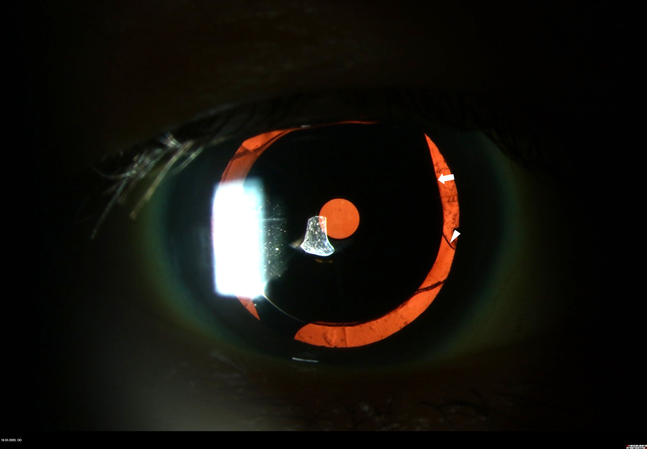Iris reconstruction with custom-made artificial iris: pupil centration and colour-matching
 {: .pic-right}
{: .pic-right}
Heidelberg 18 August 2020. The condition of Aniridia is defined by the complete or partial absence of the iris. It can be congenital or caused by a penetrant injury. We are pleased to tell you of another publication about our work on iris reconstruction using a custom-made artificial iris prosthesis - this time about the aesthetic outcome of the procedure.
The introduction of this technique to Heidelberg

Dr. Christian S. Mayer, the senior retinal lead surgeon of the Department of Ophthalmology of the Heidelberg University Hospital, introduced the technique of iris reconstruction to our group, particularly the use of an artificial iris prosthesis (AI). The procedure is not a routine surgery and each case requires an extended examination with a thorough individualized preoperative planning. Since 2010, Dr. Mayer has performed over 120 AI implantations in eyes with different conditions, including congenital and traumatic total or partial aniridia. He has published several papers on the topic in reputable journals.
Since 2017, the Heidelberg University Eye Clinic is certified as a referral centre for this technique.
What we did
In this study, we evaluated the aesthetic outcome of patients that were treated with a custom-made artificial iris prosthesis (HumanOptics, Erlangen, Germany). Patients with traumatic partial or total aniridia were included. Pre- and post-operative photographs were evaluated subjectively and objectively. Subjective evaluation was based on using questionnaires; objective assessment included measurement of pupil centration and iris colour analysis.
The Artificial Iris
The Artificial Iris (AI) we used was the ArtificialIris®, made by HumanOptics, Erlangen, Germany. The CE mark, Conformité Européenne certificate, was granted to the ArtificialIris in 2011, and it was approved by the US Food and Drug Administration in the United States in 2018.

It is designed for posterior segment implantation in aphakic and pseudophakic eyes. The AI can be implanted alone or combined with an IOL. It has a 12.8 mm overall diameter with a fixed pupil size of 3.35 mm. Its thickness decreases from the pupillary margin (0.4 mm) to the periphery (0.25 mm). The AI is made from a biocompatible silicone material that has a black posterior surface, which is optically-opaque, and a colored anterior surface. This anterior surface is a hand-painted reproduction of the patient’s iris, taken from a photograph of the patient’s residual iris tissue (RI) and the fellow eye’s iris.
A high-resolution photograph needs to be obtained from both eyes, which is then sent to the manufacturer for the implant to be individually hand-painted. By incorporating colored silicone pigments in various layers, the manufacturer creates a three-dimensional plastic surface that resembles the natural iris surface with its crypts as well as giving a natural look that minimizes light reflections.
Our results
- Patients, eye doctors, and non-specialists rated the overall aesthetic outcome good
- Mean artificial iris decentration was 0.35 ±0.24 mm and better pupil centration correlated with a higher overall score for aesthetic satisfaction
- The artificial iris was, on average, 4.65 ±10 hue-points brighter than the residual iris and fellow eye iris.

Artificial iris compared to the residual iris tissue. Close-up pre- and post-operative photographs of excellent pupil centration and colour-match between the artificial iris prosthesis and the residual iris tissue.
Conclusion
Besides improvements of functional vision parameters that Dr. Mayer reported previously (e.g. in Ophthalmology: doi:10.1016/j.ophtha.2016.01.026), the current study shows that iris reconstruction using the same custom-made artificial iris prosthesis also provides good aesthetic results. Pupil centration was a key factor correlating with the overall aesthetic satisfaction. Even though the colour matched well with the residual iris and fellow eye iris, the artificial iris was, on average, slightly brighter, and this can be taken into account when using this implant in the future.
How to cite our paper
Yildirim TM, Khoramnia R, Masyk M, Son H-S, Auffarth GU, Mayer CS (2020) Aesthetics of iris reconstruction with a custom-made artificial iris prosthesis. PLoS ONE 15(8): e0237616. https://doi.org/10.1371/journal.pone.0237616
How to get our paper
https://journals.plos.org/plosone/article?id=10.1371/journal.pone.0237616



 IOL sutured to an Artificial Iris - does it affect the IOL's optics?
IOL sutured to an Artificial Iris - does it affect the IOL's optics? 